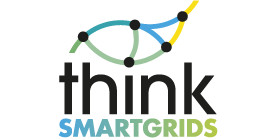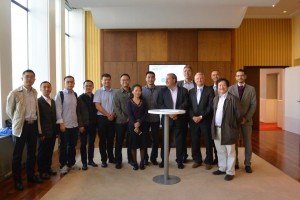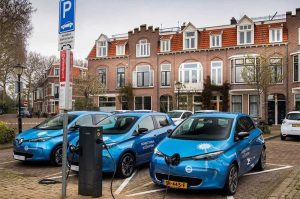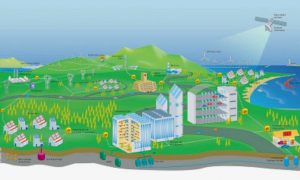[leap_dropcap style=”style-1″]B[/leap_dropcap]lockchain is increasingly presented by observers as one of the major technological breakthrough of the 21st century. The technology was introduced in 2009 with the Bitcoin. This virtual currency has surprised analysts of all sorts for creating a new currency outside the control of states and without recourse to traditional financial institutions. With this in mind, Blockchain technology is now increasingly seen as a way to revolutionize many sectors, starting with the energy sector.
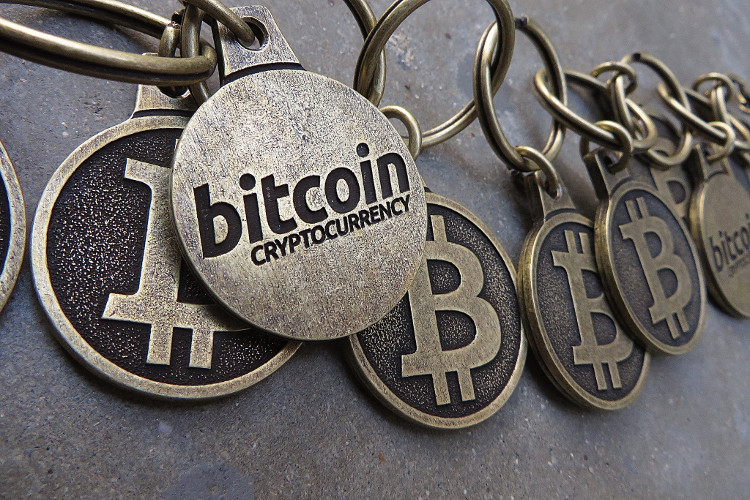
A Bitcoin Keychain – Photo credit : BTCkeychain in CC
A blockchain is a registry that is distributed over a large number of computers through a peer-to-peer network. It exploits advanced cryptology techniques making it impossible to hack and unfalsifiable. The publication of transactions made between Blockchain users allows everyone to check their validity.
This technology combines three fundamental characteristics:
[leap_ul][leap_li icon=”arrow-circle-right” iconcolor=”#a2b731″]It works without intermediaries (reducing management costs).[/leap_li][leap_li icon=”arrow-circle-right” iconcolor=”#a2b731″]It guarantees a high level of security thanks to a peer-to-peer architecture (a large number of nodes, instead of a single server).[/leap_li][leap_li icon=”arrow-circle-right” iconcolor=”#a2b731″]The data are public and anonymous.[/leap_li][/leap_ul]
Blockchains could, among other things, speed up the development of the Internet of Things by giving objects the ability to participate directly in transactions. In this approach, objects would have their own ability payment facilities. They could apply verification mechanisms, or even create their own transaction contracts.
[leap_gap height=”20px” ]
[leap_quote style=”single-quotes” bg_color=”” icon_size=”lg” icon_color=”” padding_right=”” padding_left=”” ]Blockchains are naturally of great interest in the energy sector[/leap_quote]
Blockchains are naturally of great interest in the energy sector. The first experiments were initiated by startups and focused on local solar energy exchange systems. Industrialists were quick to see the potential of this technology and launch their own initiatives.
[leap_gap height=”20px” ]
Testing by Engie, Bouygues Immobilier and GE
Engie is experimenting two types of Blockchain in the context of the European Smart Energy Aware System (SEAS) project. According to Raphaël Schoentgen, director of research and technology, Engie works with communities “to enable them to monitor the electricity grid. For example, to locate where there is a large flow of electricity, to increase the capacity of the line. The Blockchain allows you to save the information so that everyone can access it without any risk of errors.” Engie is also experimenting, in the Yonne region of France, a Blockchain infrastructure on a network of connected water meters.
[leap_gap height=”20px” ]
[leap_quote style=”single-quotes” bg_color=”” icon_size=”lg” icon_color=”” padding_right=”” padding_left=”” ]The Blockchain allows you to save information so that everyone can access it without risk of errors[/leap_quote]
Bouygues Immobilier, for its part, is exploring peer-to-peer exchange of solar energy on a neighborhood scale. According to Olivier Sellès, head of Energy Innovation and Smart Grids at Bouygues Immobilier, “there are processes that provide the share of green energy in the electricity delivered to the consumer, but nothing so far to identify the origin of production.” To this end, the group relies on the expertise of startups Energisme and Stratumn. The deployment of a pilot is announced in 2017 in a building in the district of Lyon Confluence. If the test proves conclusive, the system could be extended to other eco-districts in France.
One of the five challenges of the Digital Industry competition, organized last September by GE Digital, GE’s software and data analytics business, focused on the design of a “local, peer-to-peer system of electricity exchange based on blockchains”. “The challenge is to explore the application of blockchains to allow consumer-producers who have invested in renewable energy production (such as solar roofs) to resell their excess production to their neighbors or neighborhood, without the need of an intermediary. To ensure the security of transactions despite the lack of centralization, it is necessary to maintain a reliable and transparent history of transactions. French company Evolution Energie was selected to take up this challenge.
ITEMS International for Think Smartgrids
